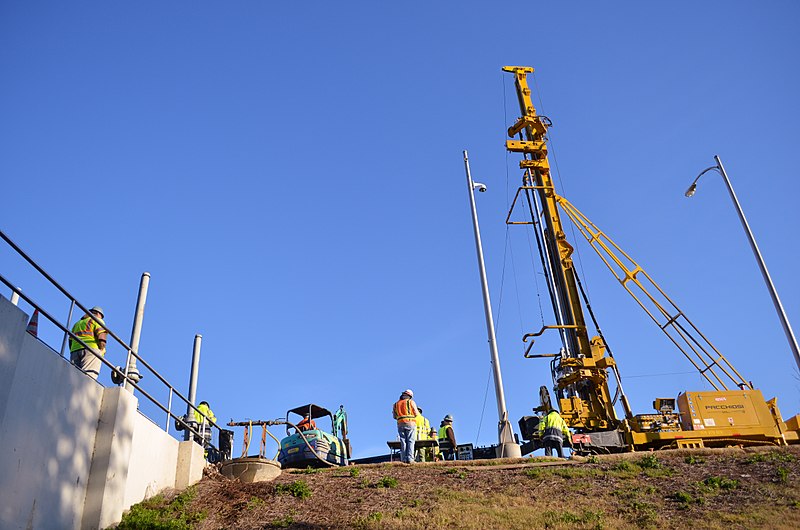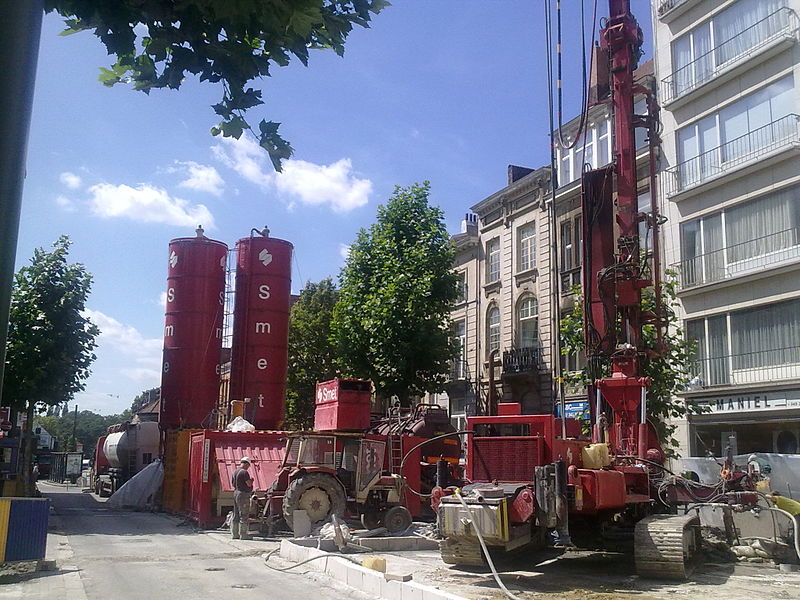What is Jet Grouting? What are its advantages and different techniques? How consolidation of soil affects jet grouting?
Jet-grouting was invented in Japan in 1965 and in a few years it became popular in all technologically advanced countries. The reasons for the fast development and popularity of this technique are essentially due to its incredible versatility. Indeed it is a grouting technique that creates in situ geometries of soilcrete (grouted soil) and can therefore can be used to treat both cohesive and non-coherent soils.
.jpg)
Advantages of Jet Grouting:
The advantages of Jet Grouting are the possibility to form consolidated columns with diameters ranging from 60 to over 300 cm, using small diameter boreholes (usually not exceeding 180 - 200 mm); and the possibility to construct soilcrete around subsurface obstructions (existing foundations, blocks, boulders and rock strata).
Another advantage is the use of lightweight and compact equipment. Being easy to be operated in confined spaces, the equipment allows to operate in direct contact with the existing superstructures that have to be consolidated by the soilcrete columns.
Different techniques of Jet Grouting:
Jet Grouting consists of an initial drilling phase followed by withdrawal of the drill string and monitor at preset and constant rotation and speed and simultaneous injection of fluid(s) at high pressure. The areas of application of Jet Grouting technology are mainly the underpinning, waterproof diaphragm walls, bottom plugs and slope consolidation.
Jet Grouting techniques are usually divided into three categories based on the number of fluids used during soil mixing: single-fluid, two-fluid and three-fluid jet-grouting:
Single-fluid system: cement grout is used as disrupting and consolidating agent.
Two-fluid system: the air-shielded cement grout is used as disrupting and consolidating agent.
Three-fluid system: a high-pressure jet of water with a collar of compressed air is used as disrupting agent, while the soil is consolidated by the cement grout.
Single-fluid system:
The single-fluid system utilizes grout as the cutting jet and to achieve cementation of the eroded soil. Column diameter on the order of 40-100 cm can be usually obtained. The hole is directly drilled by the special hollow drill rod equipped with jet monitor using rotary or roto-percussion drilling method. The monitor contains a jet nozzle at the tip and one or more lateral nozzles. During drilling, a fluid (usually water) is injected and comes out of the bottom nozzle, thus helping the tool penetrate the soil and keep its blades clean. Once the design depth is reached, the bottom nozzle is closed and the drill rod and monitor are simultaneously rotated and withdrawn.
_A.jpg)
The grout that exits the lateral jet nozzles disintegrates the soil and mixes with it to form a column of consolidated soil (soilcrete column). Besides the drill rig equipped with drill rod and monitor, the construction of mono-fluid columns implies the use of a high-pressure pump for cement grout injection, of an adequate batching plant to produce the suitable amount of grout for the process at hand, and of tanks for storing the mixture in the adequate amount and always allow the construction of the column without any interruption caused by the lack of grout.
Two-fluid system:
In this system, the water/cement mixture is encased within a shroud of compressed air. The result is a more effective cutting of the soil. The diameters that can be obtained usually range from 80 to 250 cm. in the injection area, the turbulence created by air in the waste spoil improves the efficiency of its removal.
For the two fluid system, it is required the use of special coaxial drill string with jet monitor that allows for the cement mixture and air to pass through. The hole is drilled using conventional rotary drilling or roto-percussion drilling with top hammer.
Three-fluid system:
In this system an air-enshrouded jet of water erodes the soil, while the grout is simultaneously injected through the bottom nozzles. The diameters that can be obtained usually range from 200 to 300 cm. Rotary drilling can be used to install to depth the drill string made of three coaxial rods: one for water (inner), one for air (intermediate) and one for grout (outer). The monitor is equipped with one or more coaxial nozzles for air and water and one or two nozzles for grout. If roto-percussion drilling is required, a preliminary borehole must be drilled - and cased if needed to position the jet string.
Besides the equipment needed for the bi-fluid system, tri-fluid system requires an additional high-pressure pump for water. In a few cases it is possible to use a high-pressure pump for water and an injector for grout.
Strength of consolidated soils:
The physical and mechanical properties of consolidated soils are mainly dependent on the nature and composition of the same; as a matter of fact, soil is the inert material that is added to water and cement mixture to be subsequently injected underground.
The value of unconfined compressive strength (UCS), varying from 6 to 15 MPa, may be easily obtained in coarse non-coherent soils. In such a soil type, the tri-fluid system allows to obtain higher strength than the bi-fluid or mono-fluid method.
The disrupting effect of water and the lifting effect of the air jet cause the finer portion of the soil to be removed, leaving only the coarser one, which is ultimately the true inert material for the concrete following the injection of the cement mixture. In cohesive soils, strength values decrease rapidly usually recorded at approximately 3 - 6 MPa.
A preliminary test must always be performed to assess the actual operating parameters to be used and the amount of grout to be injected in order to confirm the designers' specifications.
Evolution of Jet Grouting techniques:
The development of Jet Grouting techniques has never slowed down, mostly thanks to the variety of applications of this technique and its ability to solve many underground engineering problems and issues.
Energy optimization and efficiency maximization are two of the main focuses of Research & Development.
Nozzles were optimized to ensure higher efficiency and longer life, new rods with larger inner passage were designed to reduce pressure loss and, most importantly, new jet monitors have become the next big issue and undergo intense experimentation.
In collaboration with some universities, several tests were run on curved pipes and nozzles with different shapes to examine the print of the jet and measure the pressure values in different points of the jet cone.
The studies allowed to optimize the geometrical parameters and to increase the diameter by 25-50% for the single-fluid system and by 10-25% for the two-fluid system, considering the same operating parameters.
Examples of Jet Grouting:
Jet grouting technology has been used in the following locations:
1- The Sodra Lanken Tunnel, Stockholm
2- National heritage building , Stockholm
3- Ertan dam, southwest China
4- Hong Kong underground tunnel

References:
1- Wikipedia
2- https://theconstructor.org/geotechnical/jet-grouting-procedure-advantages/14470/
3- http://www.advancedconstructiontechniques.com/Jet-Grouting.asp
4- http://www.soletanche-bachy.com/SBF/referencesb.nsf/%28LTechnicsEN%29/Jet+grouting+%28Jet+grouting%29!OpenDocument
You received a 60.0% upvote since you are a member of geopolis and wrote in the category of "geology".
To read more about us and what we do, click here.
https://steemit.com/geopolis/@geopolis/geopolis-the-community-for-global-sciences-update-4
I did not know about Jet mining... you explained it well, i might do a better research about this, i would love to actually see a gif/video about the whole process working, pictures and words might be good but videos are even better... you got any that you recommend?
Thank you. Actually lot of videos are already available on YouTube.
nice article, upvoted
As a follower of @followforupvotes this post has been randomly selected and upvoted! Enjoy your upvote and have a great day!
Can it be used to control desertification?
No it can't be used. It is technique to increase strength of the foundations.
Congratulations! This post has been upvoted from the communal account, @minnowsupport, by munawar1235 from the Minnow Support Project. It's a witness project run by aggroed, ausbitbank, teamsteem, theprophet0, someguy123, neoxian, followbtcnews, and netuoso. The goal is to help Steemit grow by supporting Minnows. Please find us at the Peace, Abundance, and Liberty Network (PALnet) Discord Channel. It's a completely public and open space to all members of the Steemit community who voluntarily choose to be there.
If you would like to delegate to the Minnow Support Project you can do so by clicking on the following links: 50SP, 100SP, 250SP, 500SP, 1000SP, 5000SP.
Be sure to leave at least 50SP undelegated on your account.